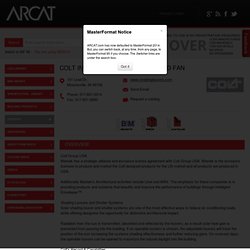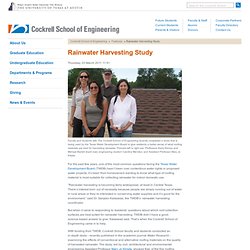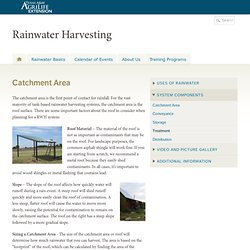

Colt International. Colt Group USA Mestek has a strategic alliance and exclusive license agreement with Colt Group USA.

Mestek is the exclusive licensee to produce and market the Colt designed products for the US market and all products are produced in USA. Additionally Mestek's Architectural activities include Linel and AWV. The emphasis for these companies is in providing products and solutions that beautify and improve the performance of buildings through Intelligent Envelopes™ Shading Louvers and Shutter Systems Solar shading louver and shutter systems are one of the most effective ways to reduce air conditioning loads, while offering designers the opportunity for distinctive architectural impact. Radiation from the sun is transmitted, absorbed and reflected by the louvers; as a result solar heat gain is prevented from passing into the building. Colt's Record & Capabilities Colt has more than 40 years experience in the design and supply of solar shading louver systems.
Course: Introduction to Small Scale Commercial Greenhouse Production. Hrt.msu.edu/Energy/Notebook/pdf/Sec3/Greenhouse_Energy_Conservation_Checklist_by_Bartok.pdf. Projects/ Urban agriculture. Urban agriculture is the practice of cultivating, processing, and distributing food in or around a village, town, or city.[1] Urban agriculture can also involve animal husbandry, aquaculture, agroforestry, Urban beekeeping, and horticulture.

These activities occur in peri-urban areas as well.[2] Urban agriculture can reflect varying levels of economic and social development. In the global north it often takes the form of a social movement for sustainable communities, where organic growers, ‘foodies’ and ‘locavores’ form social networks founded on a shared ethos of nature and community holism.
These networks can evolve when receiving formal institutional support, becoming integrated into local town planning as a ‘transition town’ movement for sustainable urban development. In the developing south, food security, nutrition and income generation are key motivations for the practice. History[edit] Perspectives[edit] Resource and economic[edit] Environmental[edit] Food security[edit] Les matériaux d'isolation. Comparaison des différents isolants Les isolants à base de fibres Les isolants à base de fibres minérales (Laine de verre, laine de roche, ...)

Ce sont les isolants les plus répandus et les moins chers. Ils possèdent une très bonne qualité d'isolation thermique mais ont peu d'inertie et gèrent mal les transferts de vapeur d'eau. Leur prix est accessible. Les isolants à base de fibres végétales (Laine de bois, de lin, de chanvre, paille, liège, ...) Gemeenschapstuinluchtbal > Onze tuin. De Gemeenschapstuin op een terrein achter de Grimsby- en Dublinstraat was het eerste onderdeel van deze ketting.

In het voorjaar van 2012 werd het niet gebruikt braakliggend terrein ingericht als een gemeenschapstuin voor de bewoners van Luchtbal. Begin 2013 werd aan het Tampicoplein een tweede tuin geopend. In beiden tuinen staan grote houten tuinierbakken, een groot tuinhuis, een serre en een paar regentonnen. Iedereen kan in de gemeenschapstuinen terecht om samen met buren, vrienden of familie groenten en fruit te kweken. Je kan er ook terecht voor een gezellige babbel. De ketting telt ook parels buiten de 2 gemeenschapstuinen: zeven scholen op Luchtbal en het dienstencentrum Santiago tuinieren mee met een eigen mobiele tuinbak. Urban Garden Map. Www.columbiaskylights.com/wp-content/uploads/ColumbiaSkylightsFrenchBrochure2013.pdf.
Rainwater Harvesting Study - Cockrell School of Engineering. Thursday, 03 March 2011 11:51 Faculty and students with The Cockrell School of Engineering recently completed a study that is being used by the Texas Water Development Board to give residents a better sense of what roofing materials are best for harvesting rainwater.

Pictured left to right are: Professors Kerry Kinney and Michael Barrett (back row); engineering student Carolina Mendez; and Assistant Professor Mary Jo Kirisits. For the past few years, one of the most common questions facing the Texas Water Development Board (TWDB) hasn’t been over contentious water rights or proposed water projects; it’s been from homeowners wanting to know what type of roofing material is most suitable for collecting rainwater for indoor domestic use. “Rainwater harvesting is becoming fairly widespread, at least in Central Texas. The test sites included both pilot-scale and full-scale residential roofs — one of which was the roof on the home of Kirisits and her husband. The U.S. Rainwater Connection - Rainwater Collection and Harvesting Systems - Rainwater Harvesting Components. Components of a Rainwater Harvesting System This section is currently out of date.

For up-to-date information, please see the RDN Rainwater Harvesting Guidebook A rainwater collection and storage system is comprised of many components. To produce good quality water all of the components need to be considered together. Rainwater collection systems can be roughly separated into two types - those where the water runs by gravity to the cistern and those where the water runs by gravity to a surge/pump tank and is then pumped to the cistern. A gravity flow to the cistern (shown above) is ideal as it requires no power. Back to top. Rainwater Harvesting. The catchment area is the first point of contact for rainfall.

For the vast majority of tank-based rainwater harvesting systems, the catchment area is the roof surface. There are some important factors about the roof to consider when planning for a RWH system: Roof Material – The material of the roof is not as important as contaminants that may be on the roof. For landscape purposes, the common asphalt shingle will work fine. If you are starting from scratch, we recommend a metal roof because they easily shed contaminants. Slope – The slope of the roof affects how quickly water will runoff during a rain event.
Sizing a Catchment Area - The size of the catchment area or roof will determine how much rainwater that you can harvest. To calculate how much rainwater that you can harvesting, use the equation below. Tubular Daylighting Devices Bring In Natural Light. Solatube.